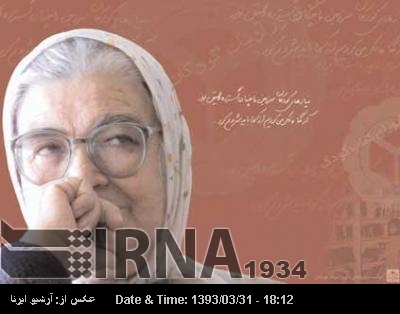ID :
332932
Sun, 06/22/2014 - 07:55
Auther :
Shortlink :
https://oananews.org/index.php//node/332932
The shortlink copeid
Touran Mirhadi, Exemplary Educator

Tehran, June 22, IRNA -- Veteran researcher and co-founder of the Children’s Book Council, Touran Mirhadi, was born in northern city of Bandar Anzali in 1927.
Mirhadi’s father was a civil engineer and her mother was a German sculptor who familiarized her with Iranian culture, according to Iran Dailyˈs Sunday edition.
Her mother placed emphasis on education of her children, encouraging them to learn other languages by saying, “Language is the gate for becoming familiar with the rich culture of other nations.”
She taught them German and recruited a language teacher to teach them French.
Mirhadi, who learned the English language in Noorbakhsh High School, said her mother taught art history in Kamal-ol-Molk Art School.
“The sculptures made by my mother were part of our life. Anybody who entered our home could see the statue of a man saying prayers in the corridor. There was also a statue of a mother holding her infant in the dining room,” she said.
“My mother made the sculptures from mud and covered them with enamel. My parents raised us in a way that we apply sciences to serve the people.”
After ending high school, Mirhadi studied biology in Tehran University. She became acquainted with Jabbar Baghchehban who reminded her of the importance of pursuing basic literacy.
Mirhadi also attended a course in educational sciences conducted by Mohammad Baqer Hoshiar in the Faculty of Literature.
These experiences made her quit biology and go to Europe to study educational sciences and psychology.
On her stay in Europe during World War II, she said, “When I went to France, it had been liberated from German occupation. The war ruins disturbed me very much. I asked why war happened, how Hitler emerged and who accepted his leadership.”
Mirhadi studied Adolf Hitler’s autocratic rule in Germany.
“I concluded that Germany’s Education Ministry had raised obedient and indecisive people. This is while a creative person decides independently, distinguishes between good and evil, and doesn’t commit a crime,” she said.
“Therefore I continued my studies in this field and in the fields of psychology, as well as education and upbringing in preschool and elementary levels. I decided to help establish an education system that nurtured broad-minded people.”
Mirhadi studied under such eminent professors as Henri Wallon and Jean Piaget.
She began a project with preschool and elementary children. However, the sudden death of his younger brother, Farhad, had a deep effect on her.
At that time, she was studying in France’s Sorbonne University. She decided to return to Iran in 1951.
She launched a kindergarten with two classrooms in 1955, naming it after her brother Farhad.
The researcher was convinced Iranian children have high mental potentials and can improve their talents through proper education. She also established a school two years later. The educational complex ran until 1980 with 1,200 students.
Mirhadi gave importance to the role of schoolchildren in running the school. One of the laws adopted by students was that teachers cannot kick out the students or punish them.
Grade was not the only criterion for advancing in studies. When a student was weak in a lesson, other students helped him to improve.
The representatives of students arranged educational tours and then all students wrote about the trip.
The presence of a good library, as the heart of the school, played a great role in the learning process.
Unfortunately, the current education system does not give credence to a comprehensive consultation system. The principal makes all the decisions unilaterally, the students only listen and study, and the teachers only teach.
Today, many graduates from Farhad School have become successful university professors in Iran and abroad. Many of them gather in Mirhadi’s house on the first Monday of every month to exchange experiences and views.
Along with 40 eminent personalities, Mirhadi compiled articles of association for establishing the Children’s Book Council of Iran. The council began to write the Iranian Encyclopedia for Young People in 1979. It is the first colored and illustrated encyclopedia written for children in Persian. It is meant as a reference book for 10- to 16-year-old children.
At first, five researchers contributed to the project. Today, over 300 are involved in writing the encyclopedia.
Some 14 volumes of the encyclopedia have so far been published and the 15th volume has been sent to the Ministry of Culture and Islamic Guidance for the publication license.
The council plans to publish the encyclopedia in 24 volumes. Children can know themselves, their people, motherland, culture and art through this encyclopedia.
The Iranian Encyclopedia for Young People can be viewed on the website www.farhangname.info, which also covers the latest news, reports and events.
Mirhadi was nominated for the 2013 Astrid Lindgren Memorial Award presented annually by the Swedish government.
The veteran researcher was nominated by the Institute for Research on the History of Children’s Literature.
The institute announced that Mirhadi had been nominated for her lifetime achievements in children’s literature.
The Astrid Lindgren Memorial Award is the world’s largest prize for children’s and young adults’ literature. It is awarded annually to a single recipient or to several individuals.
Authors, illustrators, oral storytellers and those active in promoting book reading are eligible to receive the prize./end





